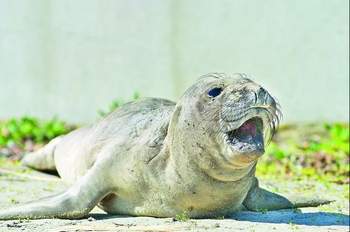This story is reproduced courtesy of the Penninsula Daily News: penninsuladailynews.com
By Rob Ollikainen
Peninsula Daily News
PORT ANGELES — A young elephant seal pup that beached itself on Hollywood Beach last weekend is more than likely a Canadian named Ninene.

A molting female elephant seal lies on the sand at Hollywood Beach in Port Angeles on Monday. Police taped off the area around the seal to keep people from approaching the animal. — Photo by Chris Tucker/Peninsula Daily News
Scientists believe the elephant seal pup that washed up near City Pier is the same seal born Jan. 30 at Race Rocks Marine Ecological Reserve. That seal was named Ninene by researchers at the British Columbia reserve.
The malnourished, scarred female seal was taken from Hollywood Beach — where Olympic Coast National Marine Sanctuary had protected her from onlookers by erecting yellow tape around her on Sunday — to the end of Ediz Hook near the Coast Guard Group/Air Station Port Angeles station on Tuesday to give her more privacy.
She was gone on Wednesday. A sanctuary scientist will check the site today.
Ninene’s life was hard, researchers said. She was weaned early and abandoned by her mother, they said, and was mauled by an adult seal when she was no more than a month old. Bob Steelquist, a spokesman at the Olympic Coast National Marine Sanctuary in Port Angeles, said, “The story gets a little richer.”
Violent childhood
Markings near the seal’s neck — signs of a violent childhood — matched those of Ninene’s, said Garry Fletcher, a volunteer at the Race Rocks reserve. “The pictures sent some evidence of that, and also Race Rocks is only 10 kilometers away,” he said. “As far as we know, we don’t know of any other elephant seals having young ones.” John Barimo, a sanctuary research specialist, said “it makes sense” that the Port Angeles seal and Ninene are one in the same. “It [Race Rocks] is the closest part of Vancouver Island to us, and the timing seems to fit,” Barimo said.
No other elephant seal is known to have been born that far north. Short of conducting a DNA analysis, scientists believe the evidence is sufficient, Barimo said.
Photos of an infant Ninene are available at www.racerocks.com.
Underweight, battered
The 10-week-old seal is severely underweight. She was weaned from her mother when she was 4 or 5 weeks old, Fletcher said. Seals usually are weaned at eight to 10 weeks. “In the first month of its life, it was attacked quite badly by a male,” Fletcher explained.
“We have a series of pictures from when its mother left. It got battered up quite badly.”
At one point, Ninene looked like she was dead, Fletcher said.
Barimo estimated the seal weighed between 100 and 125 pounds when he netted it on Tuesday. Elephant seals that age should weight about 350 pounds, he said.
“Apparently this animal was subject to pretty violent attacks by a young male over there,” Barimo said. “There are signs of the injuries that show up on its neck.” The seal’s current status is unknown. Barimo on Wednesday returned to the site where he released Ninene by the Coast Guard Group/Air Station Port Angles a day earlier. The seal was nowhere to be found.
A Makah scientist had tagged its fin with a number late Tuesday, Barimo said.
Unless Ninene reappears to humans, Barimo said it’s impossible to know if she has recovered or has become “a part of the food chain.”
The most important factor in a seal’s survival is whether or not it can learn to hunt and forage on its own, Barimo said. “It is a tough call,” he said.
“In nature, not everything makes it. . . . If it can learn to fish, it should start bulking up.”
Fletcher said: “She’s gone this far. She certainly over the worst of it.”
Once indigenous to the northwest, elephant seals were hunted out of the area in the late 1880s, Fletcher said.They survived in California and now appear to be on the rebound, Barimo said.”It was a weird twist of fate,” Barimo said.
“It was born next to a helicopter pad, and here we are releasing her at a Coast Guard station by a helicopter pad.”
________
Reporter Rob Ollikainen can be reached at 360-417-3537 or at rob.ollikainen (use the at sign) peninsuladailynews.com.
Last modified: April 09. 2009 11:39PM